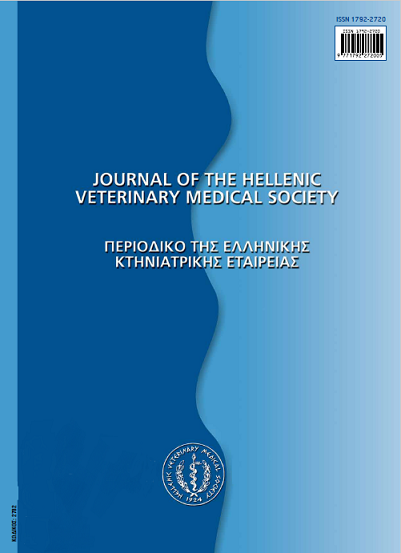Διερεύνηση των αντισωμάτων Porcine Circovirus type 2 (PCV2) σε κλινικά υγιείς κάπρουςι από αγροκτήματα της Σερβίας

Περίληψη
Στόχος της παρούσας έρευνας ήταν η διερεύνηση του επιπολασμού του κυκλοϊού τύπου 2 του χοίρου (porcinecircovirustype 2-PCV2) σε κάπρους από 3 εκτροφές της Δημοκρατίας της Σερβίας, καθώς επίσης και της πιθανής συσχέτισης με μεταβολές των αναπαραγωγικών παραμέτρων και των βιοχημικών παραμέτρων του αίματος (ολικές πρωτεΐνες, ουρία, κρεατινίνη και ασπαρτική τρανσαμινάση). Ο επιπολασμός του PCV2 αξιολογήθηκε με την παρουσία ειδικών αντισωμάτων. Με τη χρήση τεχνικής ELISA ανιχνεύθηκαν τα αντισώματα κατά του PCV2 σε ορούς αίματος 58 κάπρων από σέρβικες, εμπορικές εκτροφές. Οι 48 κάπροι προέρχονταν από τη Σερβία και οι υπόλοιποι 10 είχαν εισαχθεί από διάφορες χώρες της Ευρωπαϊκής Ένωσης. IgMPCV2-αντισώματα και/ή IgGανιχνεύθηκαν σε 51 ορούς (87.93% των κάπρων). Με βάση το είδος των ανιχνευόμενων αντισωμάτων (IgMκαι IgGPCV2-αντισώματα), διαπιστώθηκε ότι επικρατούσε η χρόνια μορφή της λοίμωξης από PCV2 στην πλειοψηφία των κάπρων που ελέγχθηκαν. Στους εισαγόμενους κάπρους, επίσης, δεν διαπιστώθηκαν τίτλοι αντισωμάτων που να υποδηλώνουν ενεργή λοίμωξη. Από τα αποτελέσματα των βιοχημικών αναλύσεων του αίματος δεν προέκυψαν σημαντικές διαφορές μεταξύ των PCV2 θετικών και αρνητικών κάπρων. Ο υψηλός επιπολασμός PCV2-αντισωμάτων που καταγράφηκε στα εξεταζόμενα δείγματα υποδεικνύει ότι ο ιός ήταν ευρέως διαδεδομένος στις εξεταζόμενες εκτροφές, ενώ υπήρξε σημαντική διαφορά στις συχνότητες ενεργούς, πρόσφατης και χρόνιας μόλυνσης από PCV2 μεταξύ των κάπρων των τριών εκτροφών (p <0,05). Ωστόσο, δεν διαπιστώθηκαν αντίστοιχες διαφορές ανάμεσα στους σέρβικους και τους εισαγόμενους κάπρους (p>0.05). Οι κάπροι που ενσωματώθηκαν στην έρευνα προέρχονταν από τρεις διαφορετικές φυλές (Landrace, DurocandYorkshire) και από τα αποτελέσματα των εξετάσεων διαπιστώθηκε σημαντικά μεγαλύτερος επιπολασμός PCV2-αντισωμάτων στους κάπρους της φυλής Landrace (p=0.003). Από την εκτίμηση των αναπαραγωγικών παραμέτρων των συών που γονιμοποιήθηκαν με σπέρμα ζώου θετικού ή αρνητικού για PCV2-αντισώματα, δεν διαπιστώθηκαν διαφορές στον αριθμό τοκετών και τα ποσοστά ζωντανών και θνησιγενών χοιριδίων, γεγονός που υποδεικνύει ότι η χρόνια λοίμωξη από τον ιό που καταγράφηκε στους κάπρους, δεν επηρέασε σημαντικά την αναπαραγωγική τους ικανότητα.
Λεπτομέρειες άρθρου
- Πώς να δημιουργήσετε Αναφορές
-
BOJKOVSKI, J., ILIĆ, V., VASIĆ, A., MALETIĆ, J., VAKANJAC, S., SAVIĆ, S., ŠTUKELJ, M., ZDRAVKOVIĆ, N., TZIKA, E. D., NICLUAE, M., & MILANOV, D. (2018). Διερεύνηση των αντισωμάτων Porcine Circovirus type 2 (PCV2) σε κλινικά υγιείς κάπρουςι από αγροκτήματα της Σερβίας. Περιοδικό της Ελληνικής Κτηνιατρικής Εταιρείας, 68(3), 347–354. https://doi.org/10.12681/jhvms.15488
- Τεύχος
- Τόμ. 68 Αρ. 3 (2017)
- Ενότητα
- Research Articles

Αυτή η εργασία είναι αδειοδοτημένη υπό το CC Αναφορά Δημιουργού – Μη Εμπορική Χρήση 4.0.
Οι συγγραφείς των άρθρων που δημοσιεύονται στο περιοδικό διατηρούν τα δικαιώματα πνευματικής ιδιοκτησίας επί των άρθρων τους, δίνοντας στο περιοδικό το δικαίωμα της πρώτης δημοσίευσης.
Άρθρα που δημοσιεύονται στο περιοδικό διατίθενται με άδεια Creative Commons 4.0 Non Commercial και σύμφωνα με την άδεια μπορούν να χρησιμοποιούνται ελεύθερα, με αναφορά στο/στη συγγραφέα και στην πρώτη δημοσίευση για μη κερδοσκοπικούς σκοπούς.
Οι συγγραφείς μπορούν να καταθέσουν το άρθρο σε ιδρυματικό ή άλλο αποθετήριο ή/και να το δημοσιεύσουν σε άλλη έκδοση, με υποχρεωτική την αναφορά πρώτης δημοσίευσης στο J Hellenic Vet Med Soc
Οι συγγραφείς ενθαρρύνονται να καταθέσουν σε αποθετήριο ή να δημοσιεύσουν την εργασία τους στο διαδίκτυο πριν ή κατά τη διαδικασία υποβολής και αξιολόγησής της.





